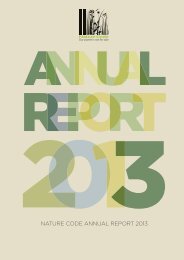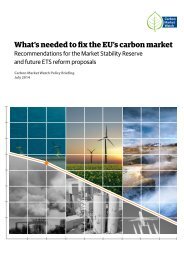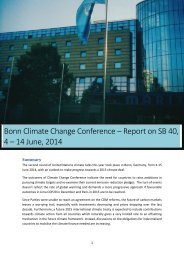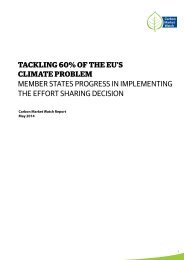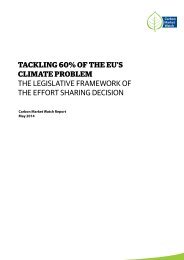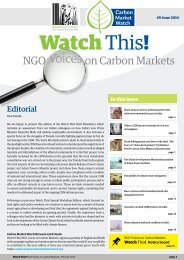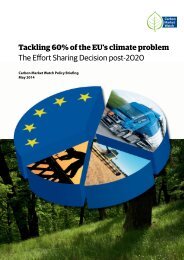Analysis of Europe’s 2030 Climate Ambition
You also want an ePaper? Increase the reach of your titles
YUMPU automatically turns print PDFs into web optimized ePapers that Google loves.
The use <strong>of</strong> flexibilities could help Member States to reach their climate targets against less costs. But<br />
contrary to the existing 2020 climate target, the new <strong>2030</strong> climate target does not allow for the use <strong>of</strong><br />
international <strong>of</strong>fsets from reductions in developing countries. To compensate for the lack <strong>of</strong><br />
international flexibilities, EU’s leaders settled on enhancing the current intra-EU trading options by<br />
allowing transfers between Member States and sectors to ensure that the most cost-effective mitigation<br />
measures are taken first.<br />
The use <strong>of</strong> EU ETS allowances to meet non-ETS climate targets<br />
EU leaders agreed that Member States with relatively high national reduction targets 6 as well as Member<br />
States without free allocation to industrial installations in 2013 7 should be allowed to use EU ETS<br />
allowances in order to meet their non-ETS climate targets.<br />
This flexibility was requested by countries that expected to have difficulties reducing their emissions in<br />
the transport and agriculture sectors, since measures to reduce CO 2 emissions in these sectors could be<br />
relatively expensive or face public resistance. In practice, this would mean that the total amount <strong>of</strong><br />
allowances under the EU ETS would be reduced, so that these allowances can be used to <strong>of</strong>fset emissions<br />
in the non-ETS sectors.<br />
However, allowing certain countries to use EU ETS allowances to count for non-ETS sector reductions<br />
could be counterproductive. The lower auctioning revenues <strong>of</strong> these governments, as a result <strong>of</strong> reduced<br />
auctioning volumes <strong>of</strong> ETS allowances, effectively reduces public resources that could otherwise be<br />
spent on mitigation efforts like improved public transportation systems or better insulated houses.<br />
Depending on the exact limit on how much ETS allowances can be used, this flexibility could reduce the<br />
incentives for emission reductions in the non-ETS sectors, potentially jeopardizing mitigation efforts in<br />
the building, transport, agriculture and waste sectors. This is because the price <strong>of</strong> ETS allowances<br />
(around €6/tCO 2-eq) is much lower than the carbon price required to enable reductions in the transport<br />
and agriculture sectors. This flexibility also reduces the demand for domestic <strong>of</strong>fsets from poorer EU<br />
countries.<br />
Introduction <strong>of</strong> a domestic <strong>of</strong>fsetting mechanism<br />
EU leaders also agreed that the existing flexibility instruments within the non-ETS sectors should be<br />
enhanced. Under the current 2020 climate framework, the Effort Sharing Decision that covers the non-<br />
ETS emissions include inter-temporal flexibilities (the possibility for Member States to shift their<br />
reduction effort between compliance years) as well as the flexibility to transfer allowances to another<br />
Member State. EU leaders propose to improve the latter flexibility instrument “in order to ensure costeffectiveness<br />
<strong>of</strong> the collective EU effort and convergence <strong>of</strong> emissions per capita by <strong>2030</strong>”. Since most<br />
<strong>of</strong> the cost-effective emission reductions are located in the lower income Member State, transfers<br />
between Member States can unlock this mitigation potential leading to cost-effectiveness <strong>of</strong> the<br />
collective EU effort.<br />
The council conclusions suggest to “significantly enhance” the transfers <strong>of</strong> allowances between Member<br />
States, since currently there is a lack <strong>of</strong> harmonized modalities for these transactions. Enactment <strong>of</strong> a<br />
project-based domestic <strong>of</strong>fsetting mechanism can provide for these harmonized modalities. Domestic<br />
<strong>of</strong>fsets could help in providing financial revenues for energy-saving projects in poorer Member States<br />
where there is still a large potential for cost-effective mitigation measures.<br />
6<br />
Probably including countries like Denmark, Luxembourg, Ireland etc.<br />
7<br />
This includes Malta, see here.<br />
7







